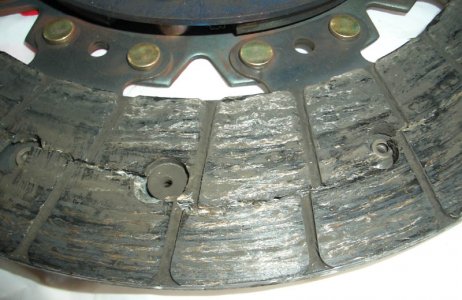Hi!
I have a problem with my clutch/gearbox. During my last track event this autumn all of a sudden I couldn’t change gear from second to third. It was no problem to go from 2:nd to neutral but no luck at all to engage third or any other gear.
I can change gear when I keep under ~1800 rpm but over no luck. When I rev the engine in gear clutch down the engine responds normally but the engine decelerates slowly. In gear clutch up the car accelerate normally (furious
A couple of weeks before this accident backing out from the garage I heard a noise like a bolt was lose somewhere in the exhaust system but since it stopped I didn’t think any more of that.
A few theories I would like some feedback on;
In regard to the chirping sound weeks before maybe one of the damper springs have come loose.
The friction plate is stuck.
Slave cylinder is bad but there is no change in fluid level and everything is dry. No fluid leaks that I can see.
Gearbox gone
My car is a 1991 5 gear MT with RPS clutch installed by a less then competent Honda dealer/shop spring 2005. (most bolts tightened with wrong torque and some without)
Do you have any theory what is wrong? Any input highly appreciated
I’ve started to disassemble the gearbox but have a few problems with that to. All the mounts to the gearbox is loose but lowering the gearbox the engine is following. The rear header is resting on the cross beam. Is it appropriate to put a jack under the oil pan or does the header handle the weight?
I have a problem with my clutch/gearbox. During my last track event this autumn all of a sudden I couldn’t change gear from second to third. It was no problem to go from 2:nd to neutral but no luck at all to engage third or any other gear.
I can change gear when I keep under ~1800 rpm but over no luck. When I rev the engine in gear clutch down the engine responds normally but the engine decelerates slowly. In gear clutch up the car accelerate normally (furious
A couple of weeks before this accident backing out from the garage I heard a noise like a bolt was lose somewhere in the exhaust system but since it stopped I didn’t think any more of that.
A few theories I would like some feedback on;
In regard to the chirping sound weeks before maybe one of the damper springs have come loose.
The friction plate is stuck.
Slave cylinder is bad but there is no change in fluid level and everything is dry. No fluid leaks that I can see.
Gearbox gone
My car is a 1991 5 gear MT with RPS clutch installed by a less then competent Honda dealer/shop spring 2005. (most bolts tightened with wrong torque and some without)
Do you have any theory what is wrong? Any input highly appreciated
I’ve started to disassemble the gearbox but have a few problems with that to. All the mounts to the gearbox is loose but lowering the gearbox the engine is following. The rear header is resting on the cross beam. Is it appropriate to put a jack under the oil pan or does the header handle the weight?





